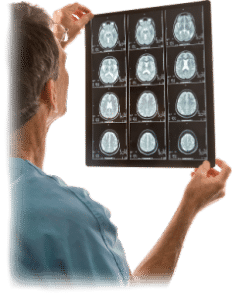
Physical Therapy After a Stroke
Physical therapy can help stroke patients recover from loss of motor control, paralysis, or muscle spasms. The brain damage caused by strokes makes daily tasks such as sitting, standing, and walking difficult. The brain can recover through stroke rehab and find new ways to perform ordinary tasks. To do so takes hard work, time, and discipline to reap the benefits of rehabilitation.
Schedule Your Free Screening Today
What happens during a stroke?
A stroke is different depending on which of the 2 types of stroke it is.
Ischemic
An Ischemic stroke is caused by a lack of blood flow. It is the result of one of 3 conditions:
- Thrombosis
Clogged blood vessels from a locally formed blood clot. - Embolism
Any blockage in a blood vessel, including an air bubble or fat. - Systemic Hypoperfusion
A cutoff of blood supply, usually caused by fainting or shock
Hemorrhagic
A hemorrhagic stroke occurs due to internal bleeding in or near the brain.
- An intracranial hemorrhage is the pooling of blood in the cranium. The cranium is the top, rounded part of your skull.
- A cerebral hemorrhage is bleeding in the brain tissue itself.
What gets damaged during a stroke?
Strokes can affect any part of the brain. The language, motor skills, and muscular response areas are the most often and deeply damaged ones.
-
- Bleeding causes the body to react to try to stop damage. Brain tissue and blood vessels break down due to the release of metalloproteases, which break down the elements of connective tissue.
- Due to blood loss, oxygen and glucose levels decrease. Processes that require energy from oxygen and glucose fail, causing brain cells to die.
- Hematomas, or swellings of clotted blood, cause compression of living and damaged tissue. The pressure can cause blood flow to vital areas to slow or stop, cutting off energy supply.
What are the effects of a stroke?
Movement & Coordination Problems
The post-stroke brain forgets how to balance. Balance is important for nearly all movements necessary for survival. Simple, instinctual tasks such as weight shifts and movement compensation methods have to be relearned by stroke victims.
Fatigue
Your brain requires blood flow and nutrition just like the rest of your body. When it has to work extra hard to compensate for functions it can no longer perform, it also needs more rest to recover. Stroke survivors will feel more tired than they have before on a regular basis.
Spasms
Misfiring brain signals cause irregular muscle movements called spasms. Damaged brain tissue sends signals to muscles without a stimulus. Involuntary movements occur without warning.
Paralysis
Stroke victims sometimes experience a loss of the sense of touch. Numbness is not uncommon and can lead to immobility. Miscommunications between muscles and the brain will cause parts of the body to become paralyzed.
Can I physically recover from a stroke?
Yes. With physical therapy and at-home rehabilitation, you can teach your body to learn new ways to move and react.
10% of stroke patients recover completely on their own. Another 25% recover with minimal damage.
Almost half of all stroke survivors need therapy or special care. If you fall into the 40% of victims that need therapy, you’ll also need a strong support system. You must be ready for a long road of hard work.
How do I begin recovery?
Stroke rehab should begin as early as possible with physical therapy. Immediately after a serious stroke, seek professional help to learn what exercises you need to perform.
Enlist the help of family and friends. Stay disciplined. The results you achieve can be reversed by neglect or underuse.
Supplement your professional rehabilitation with at-home care. If you can, have someone supervise while you exercise.
Exercises That Help During Stroke Rehabilitation
Beginner Exercises
Perform these while lying down
Intermediate Exercises
Perform these while sitting
Advanced Exercises
- Straighten arms and extend shoulders 180 degrees
- Flex elbow, hip, and knee joints by extending corresponding muscles
- Reach both hands from the floor to the ceiling while comfortably twisting your torso
- Push yourself up from a sideways laying position (horizontal torso, vertical legs) to strengthen balance during elongated movements
- Stand and support your weight with a counter or bar. Shift your weight from side to side as if walking.
- Rise from a seated position with your arms outstretched.
- Lean toward a wall and support yourself with your hands. Slowly release support from your hands and force your ankles to compensate.
How long will stroke rehabilitation take?
It will take at least a few years of disciplined exercise to see permanent results. Full recovery takes many years, but you can regain most of the motor skills you may have lost due to stroke.
How can I prevent another stroke?
Frequent doctor visits, exercise, and a healthy diet help prevent the diseases that can lead to stroke. Some habits and conditions that may induce stroke include:
- Smoking
- Sedentary Living
- High Blood Pressure
- Diabetes
- Heart Disease
- Obesity
Watch your health closely. Pay attention to your symptoms if you feel chronic headaches, dizziness, or loss of motor or speech control. It could be a sign of an oncoming stroke or disease that may cause a stroke later on. If you experience a stroke, make sure someone is available to help you find treatment immediately.

